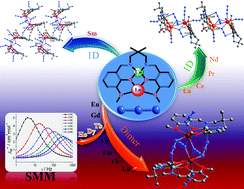Syntheses, structures, and magnetic properties of a family of end-on azido-bridged CuII–LnIII complexes†
Abstract
The reaction of Cu(valdmpn) (H2valdmpn = N,N′-bis-(3-methoxysalicylidene)-1,3-diamino-2,2-dimethylpropane), LnCl3·nH2O (Ln = La(1), Ce (2), Pr(3), Nd(4), Sm(5), Eu(6), Gd(7), Tb(8), Dy(9), Ho(10), Er(11), Tm(12), Yb(13), Lu(14)) and NaN3 in methanol led to a whole series of heterometallic CuII–LnIII complexes. The basic structural components of these complexes are the [CuII(valdmpn)LnIII] units with a compartmental Schiff-base ligand. These [CuIILnIII] units were then further connected by the end-on (EO) azides between the Ln3+ centers to form tetranuclear {[CuLn](μ-N3)n[LnCu]} motifs, where n is 3 for the complexes of larger radii lanthanides (1CuLa to 5CuSm) and 2 for the complexes of smaller radii lanthanides (6CuEu to 14CuLu). While compounds 6CuEu to 14CuLu remain isolated tetranuclear clusters, compounds 1CuLa to 5CuSm are one-dimensional chains where tetranuclear motifs are further connected by end-to-end (EE) azides between CuII and LnIII centers. Direct current (dc) magnetic susceptibilities have been measured in the range of 1.8–300 K for all complexes, revealing the different nature of magnetic interactions between the spin centers. Among them, dominant ferromagnetic interactions were found in compounds 7CuGd, 8CuTb and 9CuDy. Alternating current (ac) magnetic measurements performed on 8CuTb, 9CuDy, and 10CuHo demonstrated the presence of slow magnetic relaxation under zero applied dc field. The spin relaxation barrier Ueff was determined to be 19.54 cm−1 (28.12 K) and 10.34 cm−1 (14.87 K) for compounds 8CuTb and 9CuDy. The SMM behavior of 8CuTb was further confirmed by the presence of magnetic hysteresis loops; while no hysteresis loop was observed for 9CuDy and 10CuHo. These results demonstrated that azido-bridged copper(II)–lanthanide(III) complexes could be synthesized successfully despite the generally weak azido–lanthanide interaction.



 Please wait while we load your content...
Please wait while we load your content...